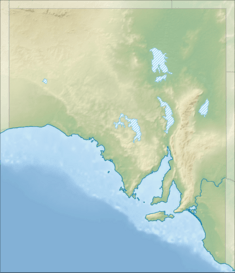Barossa Reservoir facts for kids
Quick facts for kids Barossa Reservoir |
|
|---|---|

The reservoir from its arch dam
|
|
|
Location of Barossa Reservoir in Australia South Australia
|
|
| Country | Australia |
| Location | Williamstown, South Australia |
| Coordinates | 34°39′00″S 138°50′56″E / 34.650°S 138.849°E |
| Purpose | water supply |
| Construction began | 1899 |
| Opening date | 1902 |
| Owner(s) | SA Water |
| Dam and spillways | |
| Type of dam | Arch dam |
| Impounds | Yettie Creek |
| Height | 36 metres (118 ft) |
| Length | 144 metres (472 ft) |
| Reservoir | |
| Total capacity | 4,515 megalitres (159.4×106 cu ft) |
| Surface area | 0.62 km2 (0.24 sq mi) |
| Website http://www.sawater.com.au/community-and-environment/our-water-and-sewerage-systems/water-sources/reservoir-data/barossa-reservoir |
|
Barossa Reservoir is a reservoir in the Australian state of South Australia, built between 1899 and 1902 to supply water to Gawler and other northern country areas. Built at a cost of almost A£170,000 the reservoir was hailed on completion as an engineering marvel, and with the reservoir wall rising to a height of 36 metres (118 ft), it was, at the time of its completion, the highest dam wall in Australia.
Location and features
The thin arch of the dam retaining wall, curved against the pressure of the water, was an innovation considered radical, and attracted the Reservoir international attention. It was featured in the Scientific American and caused the American Engineers News to remark that its "boldness of design deserves to rank with the most famous dams in the world". The dam is notable for its parabola effect, where a voice can be heard clearly from one side to the other — over 140 metres (460 ft), end to end. This unusual acoustic phenomenon is a popular tourist attraction, and has earned the dam the title "Whispering Wall" (see Whispering gallery).
During construction large stones were used in the wall to save concrete and tram rails were used to reinforce the upper section. The Barossa Reservoir was formed by damming the Yettie Creek gorge in the northern Mount Lofty Ranges, a feat that took over 400 men. Its water comes through a two-kilometre (one-mile) tunnel, carved by horse power, from the South Para River and Reservoir, and is supplemented by the Warren Reservoir and the River Murray. In addition to Gawler and country, a filtration plant constructed in 1982 allows the Reservoir to supply the suburbs of Munno Para and Elizabeth.
The dam's vegetated surrounds are also protected. Aside from its acoustic attraction, the Whispering Wall offers great views of both the Barossa Reservoir and the surrounding, well-preserved natural bounty. The area abounds in thick scrub, tall red gums, and pines, and a flourishing bird and animal life. It is a popular destination for picnics and bird-watching.
In 2008, its engineering heritage was recognized by the installation of a marker provided by the Engineers Australia's Engineering Heritage Recognition Program.
Key statistics
- Capacity: 4,515 megalitres (159.4×106 cu ft)
- Length of wall: 144 metres (472 ft)
- Height of wall: 36 metres (118 ft)
- Depth at wall: 28.6 metres (94 ft)
- Type of wall: Concrete arch
Gallery




